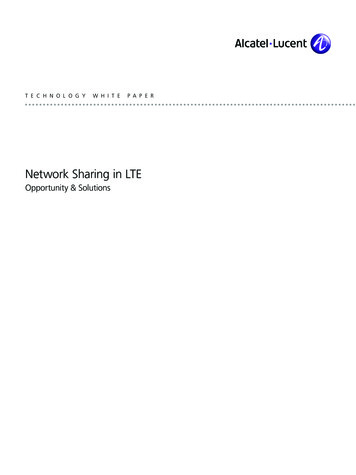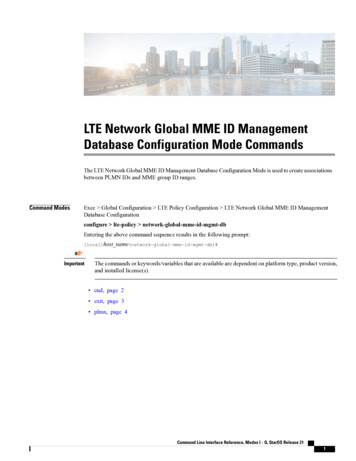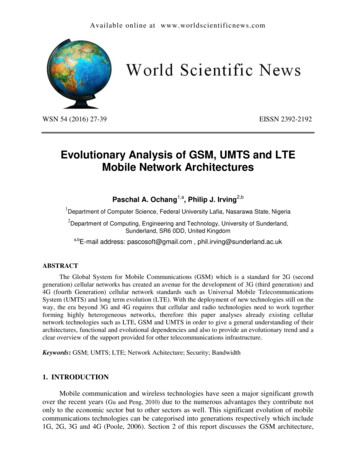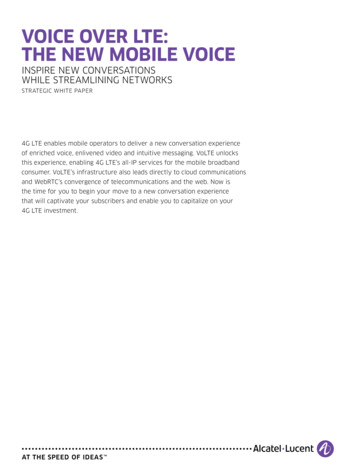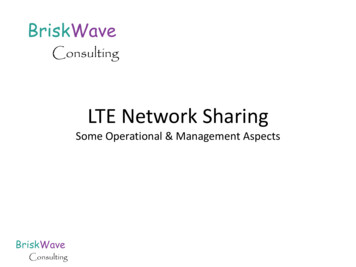
Transcription
BriskWaveConsultingLTE Network SharingSome Operational & Management AspectsBriskWaveConsulting
Contact Info Name: Luc SamsonEmail: luc.samson@briskwave.comCellular: 514 502 6654Skype: samsonlucCompany: Briskwave ConsultingBriskWaveConsulting
Executive Summary 3GPP release 8 and beyond provides LTE carriers with a richset of mandatory and optional features to support networksharing. Recent changes in the cellular industry have made LTEnetwork sharing a compelling value proposition. However, the 3GPP standard doesn’t specify how the networkmanagement domains will be shared. Partners in a shared network need to complement thestandard with operational agreements to guarantee the samelevel of operational efficiency on the shared network than ontheir dedicated network.BriskWaveConsulting
Agenda LTE Network Sharing – Overview Managing a Shared LTE Network ConclusionBriskWaveConsulting
The Triggers Lower margins at a time when competition and the need to invest rapidly on 4G technologieshave reduced carriers’ margins A change of attitude in the industry with incumbents partnering against new entrants with carriers extending their co-location and roaming agreements with regulators favoring fast broadband roll-out over collusion risks wholesalers leasing spectrum and reselling capacity All-IP Networks easing network interconnection The LTE Standard integrating advanced network sharing capabilities with higher maximumthroughput by sharing spectrum (up to 6 operators) A mature outsourcing industry facilitating the creation of Joint VenturesBriskWaveConsulting“It is expected that 30% of all LTE networks in the next five years will involve some form of activenetwork sharing“ Source: Ovum Report, ”Mobile Network Sharing – a post recession reality” Sept.14, 2010 by Emeka Obiodu
Types of Network tandard RoamingAgreementSite Sharing: site, tower,antenna, power,transmission RAN & spectrumNational version of theInternational RoamingCommon in 2G & 3GRequire operationalagreementsMost beneficial in lowtraffic & non-overlappingcoverage areasMajor Capex SavingsMajor Capex & OpexsavingsBriskWaveConsulting
Business Models for Sharing Wholesalers– Lease the spectrum– Resell capacity– Tend to focus on rural areas Joint Venture– Co-owned by the sharing partners– Manages the shared network– Broadcast multiple PLMN-IDs Geographical split– Each sharing partner manages autonomously its portion of the sharedeUTRAN– Each partner can additionally own a dedicated eUTRAN (e.g. dedicated inurban, shared in rural)BriskWaveConsulting
Active Sharing – Geographical tor SDedictedeUTRANOperator BEach sharing partner can operate a dedicated LTE network inaddition to the shared LTE network
The Benefits Capex & Opex savings particularly at the LTE network launch with low-traffic Faster time-to-market with roll-out efforts shared between sharing partners Retain Control on Competitive Differentiators on QoS, devices, services, charging & billing, customer management . Higher Customer Data Throughput by sharing spectrum No dependencies on devices with network sharing a mandatory feature in LTE devices Transparent to end-users with no impact on competitive service offerings Evolvable to a fully dedicated network enabling carriers to selectively evolve the shared component into a fullydedicated networkBriskWaveConsulting
Network Sharing Cost BenefitsBriskWave Source: Vodafone ulting
Sharing SpectrumBriskWaveConsultingDL Throughput vs Distance Relative to Cell-Edge1405 MHz12010 MHz100Mbps Sharing spectrum increasesthe data throughput acrossthe cell Initially, only contiguouschannels in the same bandcan be shared With LTE-advanced, noncontiguous channels canalso be shared20 MHz80604020000.10.20.30.40.50.60.70.80.91
Active Sharing – Some announcementsTelenor & Tele2T-mobile & 3Bell & TelusPTC & PTKVodafone & O2LightsquaredOrange & P4Vodafone & OrangeTelstra & 3Vodafone & TIMZain & EssarVodacom & al3GLTEBriskWaveConsultingOptus & VodafoneTelstra & H3G
Active Sharing: The Options Sharing at Different Network Levels–– Security– Partners can control QoS via the standard QOS Class Identifier (QCI) values (1-9)Partners can additionally configure operator-specific QCIsDedicated & Shared SpectrumDedicated & Shared BackhaulMobility Profiles – Specific Per Partner––– IPSec-based VLAN per operatorQOS Management–– eUTRAN only (i.e. MOCN)eUTRAN and partially Core (i.e. GWCN)Intra-LTE from shared to sharedIntra-LTE from shared to dedicatedInter-RAT from shared to dedicatedVoice Support – Specific Per Partner––CSFBVoLTEBriskWaveConsultingThe 3GPP LTE standard offers a wide range of network sharingoptions that enhance the value proposition of active sharing
Sharing Options: MOCN vs dSpectrumShared orDedicatedSpectrumShared orDedicatedMulti-Operator Core Network (MOCN)Gateway Core Network (GWCN) No need for MME interfaces to partner’s MSC & SGSN No need for HSS addresses of all roaming partners Lower Costs with shared MMEBriskWaveConsulting
MOCN: How does it work?UEOperator BSharedeNodeBMMEOperator AMMEOperator B The UE selects its operatorand indicates the selectedPLMN-ID in the RRC ConnectionrequestSystem Info“PLMN-A PLMN-B”UE decodes theNetwork sharing infoUE selects the appropriate PLMNRRC ConnectionAttach RequestAttach RequestAttach RequestAcceptedAttach RequestAccepted The PLMN-IDs of partners areall broadcasted on the airinterfaceUE allowed to attach The eNodeB forwards theattachment request to an MMEbelonging to the appropriateoperator 3GPP TS 23.251 & TR 22.951The MME is selected based on the PLMN-ID provided by the UEBriskWaveConsulting
What is not in the Standard? Enhanced Product Options– Capacity sharing features: fully-pooled, fully-Split, partial reservation– Usage Information & Counters: segregation by PLMN-ID– QoS Management: policing, traffic-shaping per operator Network Management Considerations–––––Fault ManagementConfiguration ManagementAccounting ManagementPerformance ManagementSecurity Management Business Considerations– Planning & sharing network expenditures– Private in-building customers– The network sharing agreement needs to address key product,network management, and commercial considerations.BriskWaveConsulting
Agenda LTE Network Sharing – Overview Managing a Shared LTE Network ConclusionBriskWaveConsulting
The Principles of Shared Network Network Management : although only one partner isaccountable to actively manage its portion of the sharednetwork, both partners are accountable to define, supervise,and monitor the network management practices. Customer Management : each sharing partner shall retainboth the full control over the management of their customersand the capability to cater to their satisfaction as if they wereserved on their dedicated network. Business Management : optionally, including some businessmanagement domains in the sharing agreement can improvethe operational efficiency of the partners even further, whilepreserving a desired level of competition among them.BriskWaveConsulting
Management ManagementFault ManagementVendor ManagementService QualityManagementConfigurationManagementCapacity ManagementAccounting ManagementNetwork PlanningPerformanceManagementBenchmarkingSecurity ManagementPrivate In-buildingCustomer CareRoaming AgreementsSome management domains to address in individual operationalagreements within the network sharing agreementBriskWaveConsulting
Operational Agreements: Overview Goals : defining the purpose of the specific operational agreement Data & Reporting : data to be exchanged and/or reported, inline vs. offline, format, frequency, availability & retention, and others Process : defining primes, mandate, schedule of meetings, data/report tobe reviewed, clear scope of accountability, targets, and others. Board Review: defining board members, schedule of meetings, role &responsibilities regarding resolution of disputes, process changes, andothers. Operational Sharing Infrastructure: defining the requirements for theinfrastructure to share/exchange data and reports.The network sharing shall include a set of operational agreements, one tocover each management domain.BriskWaveConsulting
Operational Sharing InfrastructureNetwork ManagersMeetingsOSS/BSS SystemsReportsNetwork ManagementSystemsProcessed DataElement ManagerSystemsUnprocessed DataNetwork ElementsBriskWaveConsultingOperator AOperator B
Performance ManagementFrequencyData ExchangeNear real-timeReportingReview MeetingsProcess Board MeetingsFormat Unprocessed PM counters & KPIsMonthly Reports on KPIs vs. targets Busy-hour, daily, weekly Market-, eNb-, cell-levelMonthly RF Engineering Primes Identify Action Plan Report on Resolution timeQuarterly Executive attendance Define KPIs and targets Define/review the processGOALSBriskWaveConsulting1.2.3.Provide visibility into the shared network performanceDefine minimum network performance targetsProvide a process to identify and address performanceissues within an agreed resolution time
Configuration ManagementFrequencyData ExchangeDailyReview MeetingsMonthlyProcess Board MeetingsQuarterlyFormat Unprocessed eNB & cellconfiguration data RF Engineering PrimesIdentify Configuration IssuesReport on Resolution timeAgree on Schedule forConfiguration Changes Executive attendance Define/review the processGOALSBriskWaveConsulting1.2.3.Provide visibility into shared network configurationAlign and prioritize network configuration changesProvide a process to identify and address configurationissues within an agreed resolution time
Fault ManagementFrequencyFormatData ExchangeReal-time Unprocessed alarms & logsReportingMonthly Network Issue Reports Open, pending, closed ticketsMonthly Engineering Primes Review Open Issues Ticket Resolution TimeReview MeetingsProcess Board MeetingsYearly Executive attendance Define/review the processGOALSBriskWaveConsulting1.2.3.Define minimum SLA for network issuesProvide visibility into shared network issuesProvide a process to identify and address networkissues within an agreed resolution time
Capacity ManagementFrequencyFormatData ExchangeReal-time Capacity-based Threshold CrossingAlarmsReportingMonthly Capacity Utilization ReportsQuarterly Capacity Engineering Primes Share Forecasts Identify Capacity Bottlenecks Prepare the Capacity Upgrade PlanReview MeetingsProcess Board MeetingsYearly Executive attendance Capacity Metrics and Thresholds Define/review the processGOALS1.2.3.Guarantee enough capacity (access, transport .) to meet future needsAgree on capacity guidelines and thresholdsMinimize CAPEX spendingsBriskWaveConsulting
Vendor ManagementFrequencyReportingMonthlyReview MeetingsProcess Board MeetingsFormat List of open issues with vendorsAd hoc Vendor Roadmap Planning Vendor Support Issues Joint Test PlanningYearly Executive attendance Define/review the process Select common vendorsGOALS1.2.3.4.5.BriskWaveConsultingAlign vendors’ roadmap to shared partners’ requirementsIncrease the negotiation leverageMaximize vendors’ support & maintenanceShare vendors’ issues & resolutionShare/reduce test efforts on new releases
BenchmarkingFrequencyData ExchangeAd hocReportingReview MeetingsProcess Board MeetingsFormat Unprocessed benchmarking anddrive-test dataMonthly Drive-test resultsMonthly RF Engineering Primes Plan Benchmarking Campaigns Identify action plan & ResolutiontimeYearly Executive attendance Define/review the processGOALS1.2.3.BriskWaveConsultingAlign benchmarking methodologies and toolsShare drive-test effortsGuarantee “best-in-class” network performance
Customer Care ManagementFrequencyData ExchangeReportingReview MeetingsProcess Board MeetingsNear real-timeFormat Customer Trouble TicketsMonthly Open Tickets Resolution TimeMonthly Customer Support Primes Identify action plan Resolution timeQuarterly Executive attendance Align Ticket Definition & Priorities Define/review the processGOALS1.2.3.Define SLA for ticket resolutionProvide an escalation mechanism into partner’s third-level supportProvide a process to identify and address customer complaintsBriskWave within an agreed resolution timeConsulting
Operational Agreement Checklist Identify pre-sharing & sharing-specific data requirement for all OSS & BSSProcesses & Tools affected by the network sharing– Data– Interfaces & Protocol– SLA & Processes Identify all the management domains to be covered in the networksharing agreement For each domain, define an operational agreement Set-up an infrastructure to exchange data & reporting Define OSS-related network requirements to support network sharing Consider including some business management domains Insure overall consistency with the evolution and exit strategyBriskWaveConsulting
Operational Agreements: Overview Goals : defining the purpose of the specific operational agreement Data & Reporting : data to be exchanged and/or reported, inline vs. offline, format, frequency, availability & retention, and others Process : defining primes, mandate, schedule of meetings, data/report tobe reviewed, clear scope of accountability, targets, and others. Board Review: defining board members, schedule of meetings, role &responsibilities regarding resolution of disputes, process changes, andothers. Operational Sharing Infrastructure: defining the requirements for theinfrastructure to share/exchange data and reports.The network sharing shall include a set of operational agreements, one tocover each manageme
Contact Info. Name: Luc Samson Email: luc.samson@briskwave.com Cellular: 514 502 6654 Skype: samsonluc Company: Briskwave Consulting. BriskWave. Consulting. Executive Summary. 3GPP release 8 and beyond provides LTE carriers with a rich set of File Size: 2MBPage Count: 34
